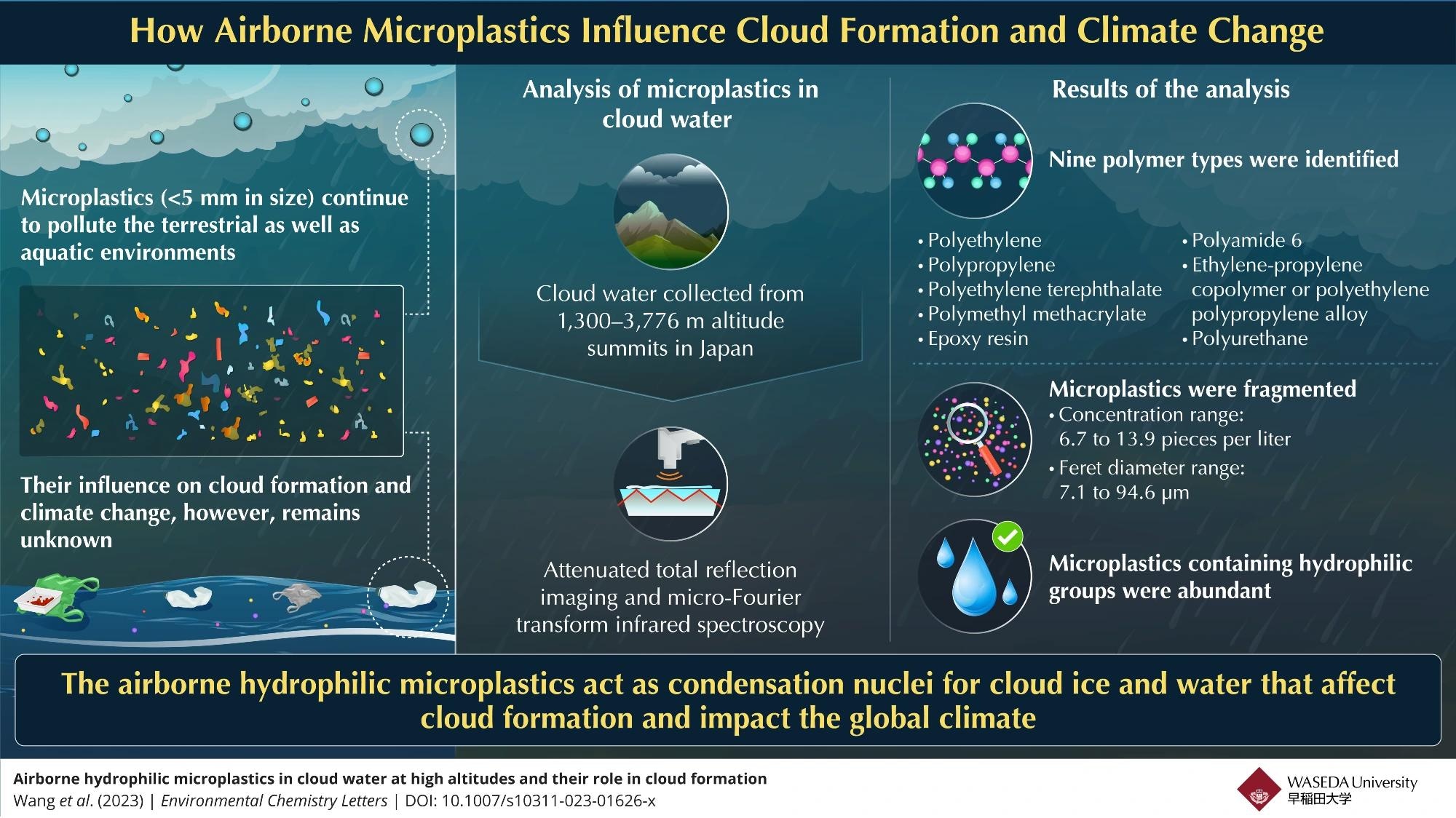Microplastics, which are created when plastic debris builds up on land, eventually end up in the ocean. Microplastics could also be found in clouds in the sky, according to recent speculation. In a recent study, scientists measured the concentration of microplastics in cloud water samples collected from high-altitude mountains in Japan. They also provided information on the detrimental effects of these airborne particles on the climate and how they affect cloud formation.
 According to the findings of a new study, AMPs were detected in cloud water samples from mountain summits in Japan, which confirms that they play a key role in rapid cloud formation. Image Credit: Hiroshi Okochi from Waseda University
According to the findings of a new study, AMPs were detected in cloud water samples from mountain summits in Japan, which confirms that they play a key role in rapid cloud formation. Image Credit: Hiroshi Okochi from Waseda University
Microplastics are defined as plastic particles smaller than 5 mm. The decomposition of larger plastic waste produces these microscopic plastic particles, which are frequently detected in industrial effluents. According to research, huge amounts of microplastics are consumed or inhaled by both people and animals, and they have been found in many different organs, including the heart, lungs, blood, placenta, and feces.
Ten million tons of these plastic fragments wind up in the ocean, where they are dispersed by the ocean spray and eventually into the atmosphere.
This suggests that microplastics have become a necessary part of clouds, polluting almost all of the food and drink through “plastic rainfall.” Few studies on microplastics have examined their effects as “airborne particles” on cloud formation and climate change, despite the majority of them concentrating on aquatic environments.
A team of Japanese researchers has examined the course taken by airborne microplastics (AMPs), which have a negative effect on human health and the climate, as they circulate in the biosphere in a new study under the direction of Waseda University Professor Hiroshi Okochi.
Their research was recently published in the journal Environmental Chemistry Letters with co-authors Yasuhiro Niida from PerkinElmer Japan Co. Ltd. and Yize Wang from Waseda University.
Microplastics in the free troposphere are transported and contribute to global pollution. If the issue of ‘plastic air pollution’ is not addressed proactively, climate change and ecological risks may become a reality, causing irreversible and serious environmental damage in the future.
Hiroshi Okoch, Professor, Waseda University
The team collected cloud water from the summits of Mount (Mt.) Fuji, the south-eastern foothills of Mt. Fuji (Tarobo), and the summit of Mt. Oyama—regions at altitudes ranging between 1300–3776 m—to study the role of these small plastic particles in the troposphere and the atmospheric boundary layer.
The researchers identified the presence of microplastics in the cloud water and investigated their physical and chemical characteristics using cutting-edge imaging techniques, including attenuated total reflection imaging and micro-Fourier transform infrared spectroscopy (FTIR ATR imaging).
In the AMPs discovered, they discovered nine distinct kinds of polymers and a single type of rubber. Notably, the majority of the polypropylene that was found in the samples contained hydroxyl (OH) and/or carbonyl (C=O) groups and deteriorated. These AMPs have the lowest Feret diameters ever recorded in the free troposphere, ranging from 7.1 to 94.6 m.
Additionally, the cloud water included a lot of hydrophilic (water-loving) polymers, which could have been removed as “cloud condensation nuclei.” These results demonstrate that AMPs are essential for fast cloud formation, which may ultimately have an impact on the climate.
The buildup of AMPs in the atmosphere, particularly in the polar regions, could significantly affect the planet’s ecological equilibrium and result in a considerable loss of species.
Okochi concluded, “AMPs are degraded much faster in the upper atmosphere than on the ground due to strong ultraviolet radiation, and this degradation releases greenhouse gases and contributes to global warming. As a result, the findings of this study can be used to account for the effects of AMPs in future global warming projections.”
Journal Reference:
Wang, Y., et al. (2023) Airborne hydrophilic microplastics in cloud water at high altitudes and their role in cloud formation. Environmental Chemistry Letters. doi:10.1007/s10311-023-01626-x